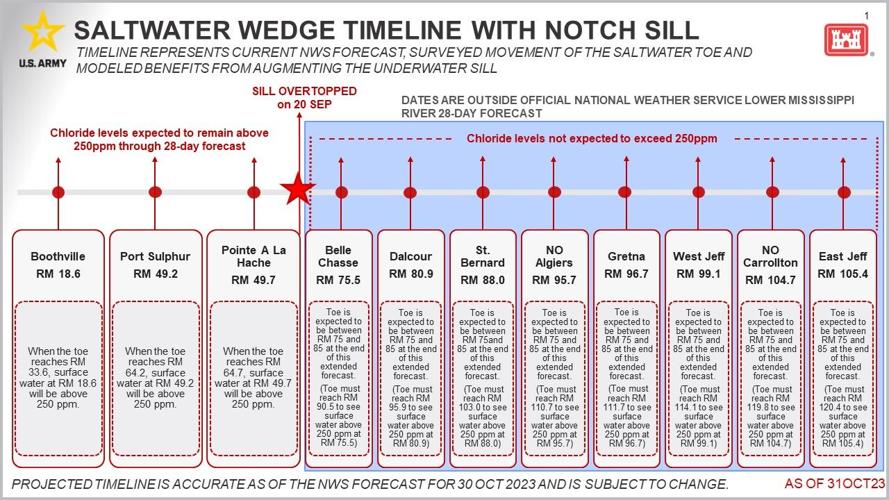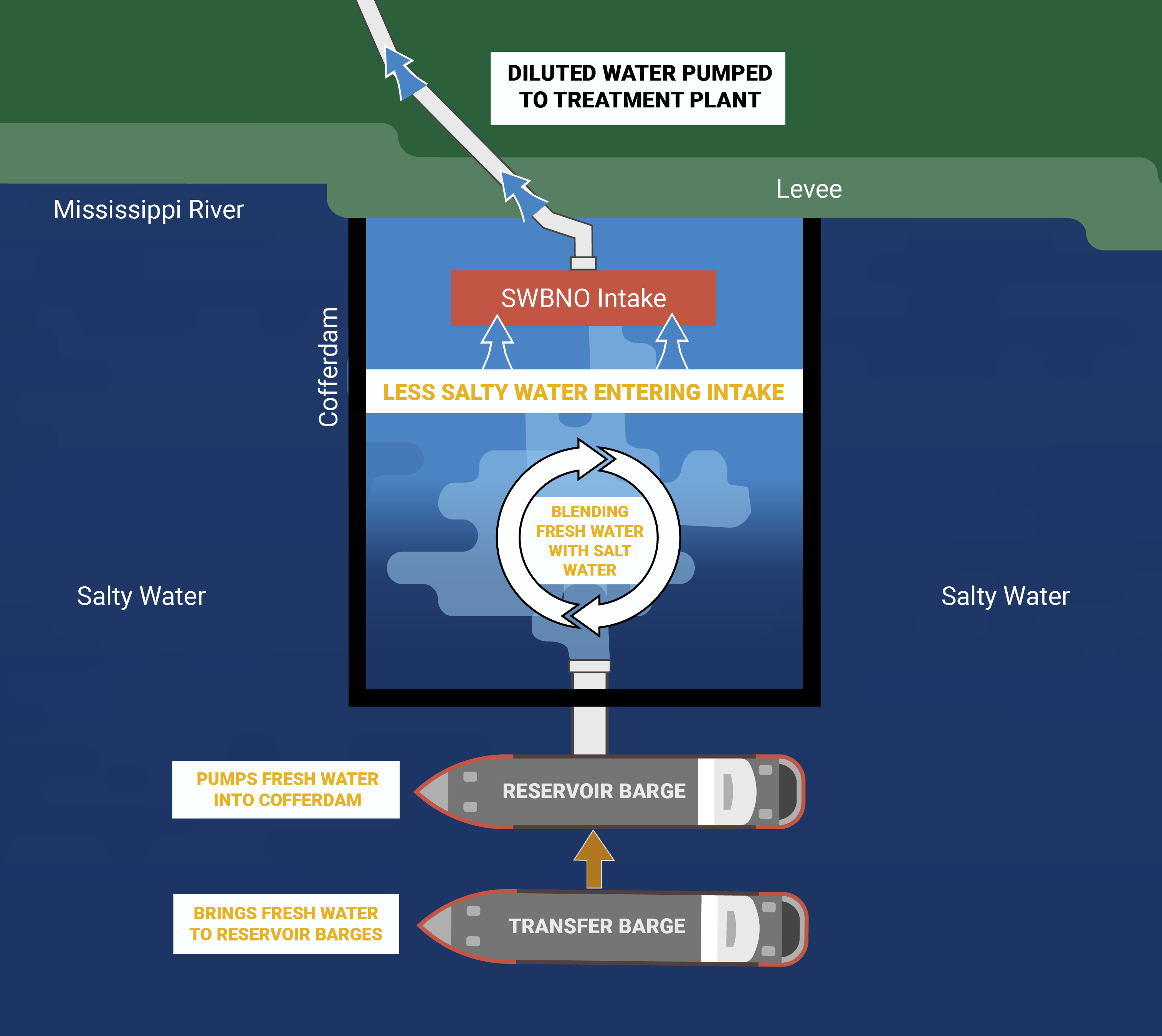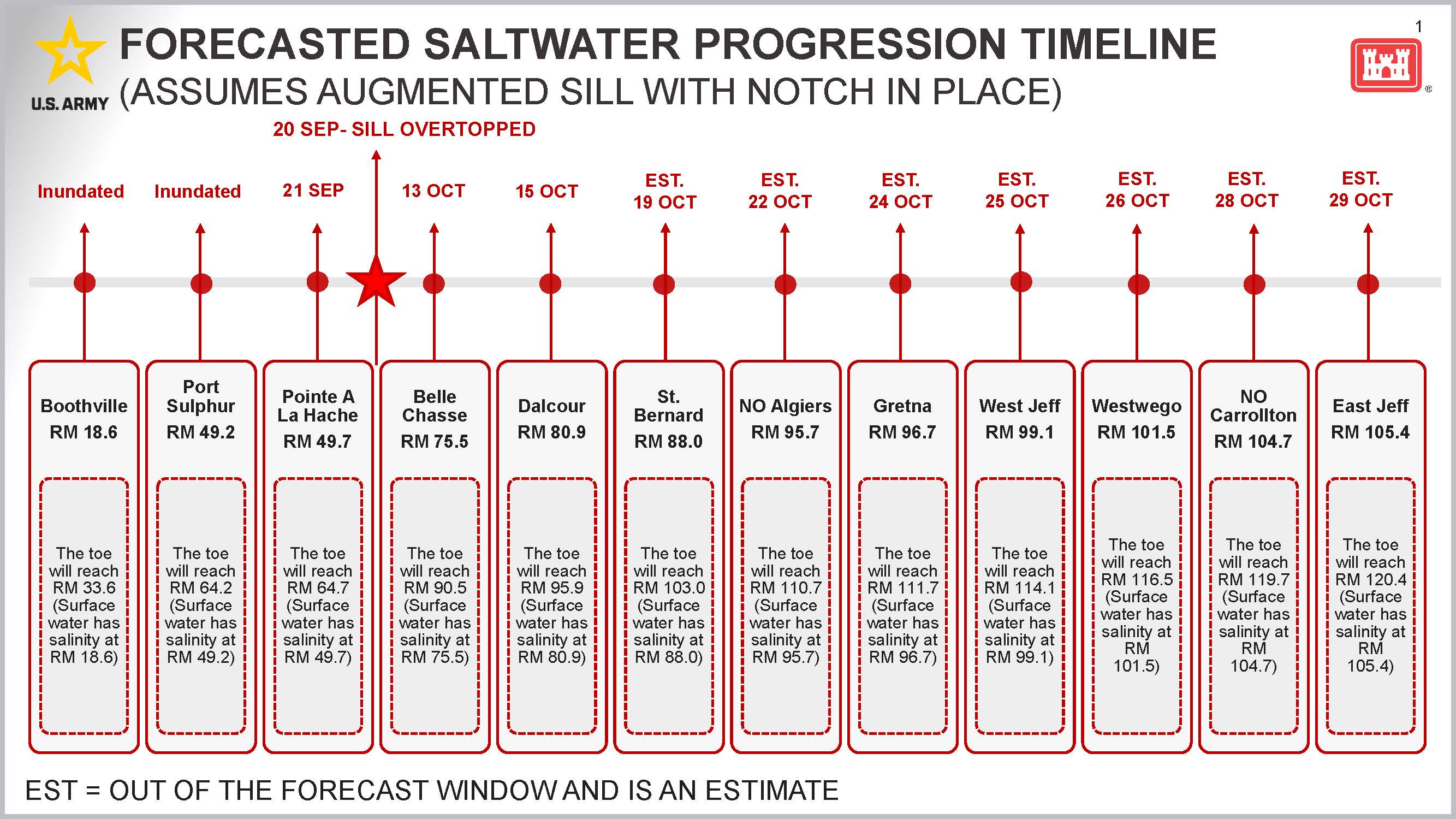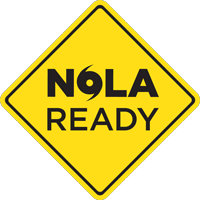Saltwater Wedge Intrusion
SWBNO’s water is safe to use for all purposes.
Salt water has not reached Orleans Parish. In partnership with local, regional, and federal partners, we will keep our customers updated.
SWBNO News and Updates
UPDATED PROJECTIONS from the U.S. Army Corps of Engineers:
- Algiers: Chloride not expected to exceed 250ppm
- Carrollton: Chloride not expected to exceed 250 ppm
Subject to change

Next Steps
- Westbank & Eastbank: Based on the current forecast, SWBNO will continue monitoring the situation and resume mitigation efforts should the timeline shift in the coming weeks.
Press Releases
SWBNO’s Daily Chloride Level
9/1/23 - 11/28/23
Testing for chloride allows us to estimate salt levels in the Mississippi River and our tap water. Every day, we measure chloride before and after water treatment for the Eastbank and Algiers. Below are those daily results.
SWBNO recognizes that your primary concern as a customer is the water that comes into your homes and businesses. Providing safe drinking water is our top priority, and we are committed to keeping you informed throughout this event. We will let you know well in advance of any changes or impacts.
There is no one-size-fits-all solution across SWBNO’s Eastbank and Westbank intakes or even across parishes. Different intake sizes, locations, and drinking water needs require different approaches.
WESTBANK
Timeline: Not expected to exceed 250ppm
What's Next: Based on the current forecast, we are confident our Algiers intakes will not see increased salinity levels. SWBNO will continue monitoring the situation with daily chloride testing and corrosion sampling in coordination with the Louisiana Department of Health and the Louisiana Department of Environmental Quality. We will resume mitigation efforts should the timeline shift in the coming weeks.
EASTBANK
Timeline: Not expected to exceed 250ppm
What’s Next: Based on the current forecast, we are confident our Algiers intakes will not see increased salinity levels. SWBNO will continue monitoring the situation with daily chloride testing and corrosion sampling in coordination with the Louisiana Department of Health and the Louisiana Department of Environmental Quality. We will resume mitigation efforts should the timeline shift in the coming weeks.
Blending
The water at our intakes is not anticipated to go above the High Sodium Water Advisory limit of 250 parts per million. But, any salinity levels higher than our usual range (20ppm to 60ppm) could still impact our drinking water supply. We are continuing to monitor the situation with daily chloride tests. If we see elevated chloride levels showing the river water is saltier than normal, we will continue exploring blending options.
Here's how blending would work for Algiers. We would coordinate with the U.S. Army Corps of Engineers (USACE) to barge in 14 million gallons of fresh water daily to blend with the salty river water before it’s collected into Algiers’ intakes.

If the saltwater wedge begins to impact Algiers, all Westbank customers will play a vital role in the quality of our tap water. Once we begin blending efforts, conservation will be important. The less tap water used, the further that fresh water goes. Jump down for some tips on how to conserve water so you can protect yourselves, your neighbors, and those you care about.
Saltwater Intrusion FAQs
Download printable version of FAQs
Salinity is the amount of salt dissolved in water. Salt is also known as sodium chloride. Below is a scale showing the salinity of various water sources ranging from fresh water to ocean water. (ppm = parts per million).
Health Impacts
In partnership with the Environmental Protection Agency (EPA), we will issue an advisory if chloride levels reach 250 parts per million.
However, if you notice an unusual taste, odor, or appearance in your tap water, contact SWBNO at (504) 52-WATER.
Introducing salt water to our system could undermine our current corrosion prevention methods. This could cause substances like iron and lead from older pipes in our water system to dissolve into the treated water.
We need more data to understand the impacts higher salt levels may have. We are working with top experts at LDH and the EPA to prepare a corrosion sampling plan to increase our testing for lead and many other substances. We will work with our partners to address impacts swiftly with a full range of resources.
If the amount of chloride in our drinking water reaches 250 parts per million, alternate sources of drinking water and cooking water will be necessary. The Governor’s Office of Homeland Security and Emergency Preparedness will support SWBNO and the City of New Orleans in providing drinking water if needed. If you are concerned about your water, contact (504) 52-WATER.
You can also visit the following resources to learn how to limit exposure to corroded metals in your drinking water.
What Can You Do Now
According to the Louisiana Department of Health:
For infants, use bottled spring/purified water to prepare formula if breastfeeding is not an option. Ready-to-feed formula (“RTF”) or pre-made formula is also an option. When using formula, be sure to follow your child’s primary healthcare provider and manufacturer’s instructions for preparing and storing formula.
Learn more: Saltwater Intrusion
You will not be able to reduce or eliminate salt from your tap water at home. Salt is extremely difficult to remove from drinking water and cannot be taken out through boiling or conventional filtration like Brita filters or other common household store-bought water filters.
We will inform customers as soon as possible if and when New Orleans water becomes impacted by salt water. In partnership with city and state agencies, we will provide guidance for customers and their drinking water consumption
Should I conserve water? Conservation practices are always a good idea and become even more important if and when salt water arrives. As always, we will continue to keep our customers informed well in advance of any proposed changes to their water use.
Visit the Center for Disease Control’s (CDC) website for guidance on how to safely store water: https://www.cdc.gov/healthywater/emergency/creating-storing-emergency-water-supply.html
What is SWBNO Doing?
Infrastructure and Property Impacts
Resources From Our Partners
September 26, 2023
Check the status and location of the Saltwater Wedge (Source: US Army Corps of Engineers)

September 26, 2023
Visit the Governor's Office of Homeland Security and Emergency Preparedness for regular updates
September 26, 2023
LSU AgCenter Update – Information about Saltwater Impact to Plants and Livestock

September 25, 2023
Louisiana Department of Health’s FAQs on Saltwater Intrusion
Chloride Level Data
| Date | Carrollton River Intake | Carrollton Tap | Algiers River Intake | Algiers Tap |
|---|---|---|---|---|
| 2023/11/28 | 51 | 53 | 54 | 56 |
| 2023/11/27 | 50 | 48 | 45 | 49 |
| 2023/11/26 | 44 | 51 | 47 | 52 |
| 2023/11/25 | 49 | 53 | 50 | 56 |
| 2023/11/24 | 51 | 55 | 54 | 56 |
| 2023/11/23 | 51 | 50 | 48 | 52 |
| 2023/11/22 | 44 | 47 | 44 | 48 |
| 2023/11/21 | 43 | 47 | 45 | 50 |
| 2023/11/20 | 44 | 48 | 45 | 51 |
| 2023/11/19 | 46 | 47 | 46 | 49 |
| 2023/11/18 | 44 | 47 | 44 | 48 |
| 2023/11/17 | 44 | 53 | 47 | 54 |
| 2023/11/16 | 51 | 54 | 51 | 57 |
| 2023/11/15 | 48 | 58 | 53 | 60 |
| 2023/11/14 | 55 | 62 | 56 | 64 |
| 2023/11/13 | 71 | 78 | 78 | 82 |
| 2023/11/12 | 74 | 68 | 73 | 74 |
| 2023/11/11 | 60 | 53 | 54 | 59 |
| 2023/11/10 | 48 | 54 | 50 | 53 |
| 2023/11/09 | 45 | 50 | 47 | 52 |
| 2023/11/08 | 44 | 48 | 43 | 47 |
| 2023/11/07 | 45 | 50 | 43 | 50 |
| 2023/11/06 | 50 | 54 | 49 | 54 |
| 2023/11/05 | 54 | 51 | 51 | 53 |
| 2023/11/04 | 45 | 47 | 42 | 47 |
| 2023/11/03 | 43 | 48 | 41 | 47 |
| 2023/11/02 | 46 | 50 | 43 | 49 |
| 2023/11/01 | 48 | 49 | 44 | 51 |
| 2023/10/31 | 46 | 55 | 49 | 56 |
| 2023/10/30 | 50 | 55 | 50 | 55 |
| 2023/10/29 | 45 | 47 | 45 | 50 |
| 2023/10/28 | 44 | 50 | 46 | 53 |
| 2023/10/27 | 47 | 53 | 49 | 56 |
| 2023/10/26 | 48 | 55 | 49 | 56 |
| 2023/10/25 | 46 | 57 | 51 | 59 |
| 2023/10/24 | 56 | 60 | 58 | 61 |
| 2023/10/23 | 55 | 58 | 57 | 61 |
| 2023/10/22 | 54 | 58 | 54 | 60 |
| 2023/10/21 | 54 | 50 | 50 | 54 |
| 2023/10/20 | 45 | 47 | 43 | 47 |
| 2023/10/19 | 42 | 46 | 41 | 45 |
| 2023/10/18 | 41 | 49 | 42 | 49 |
| 2023/10/17 | 47 | 53 | 49 | 54 |
| 2023/10/16 | 47 | 53 | 48 | 54 |
| 2023/10/15 | 47 | 53 | 48 | 54 |
| 2023/10/14 | 49 | 54 | 48 | 54 |
| 2023/10/13 | 47 | 55 | 47 | 51 |
| 2023/10/12 | 51 | 61 | 56 | 65 |
| 2023/10/11 | 59 | 61 | 65 | 69 |
| 2023/10/10 | 54 | 56 | 52 | 56 |
| 2023/10/09 | 47 | 60 | 53 | 59 |
| 2023/10/08 | 49 | 50 | 46 | 53 |
| 2023/10/07 | 46 | 51 | 50 | 56 |
| 2023/10/06 | 47 | 49 | 46 | 52 |
| 2023/10/05 | 47 | 52 | 47 | 53 |
| 2023/10/04 | 48 | 52 | 44 | 50 |
| 2023/10/03 | 48 | 49 | 44 | 47 |
| 2023/10/02 | 46 | 53 | 47 | 54 |
| 2023/10/01 | 49 | 52 | 48 | 51 |
| 2023/09/30 | 47 | 53 | 47 | 53 |
| 2023/09/29 | 46 | 51 | 46 | 52 |
| 2023/09/28 | 46 | 54 | 48 | 54 |
| 2023/09/27 | 48 | 52 | 47 | 53 |
| 2023/09/26 | 43 | 48 | 45 | 51 |
| 2023/09/25 | 46 | 55 | 46 | 54 |
| 2023/09/24 | 49 | 55 | 52 | 58 |
| 2023/09/23 | 54 | 52 | 52 | 57 |
| 2023/09/22 | 48 | 53 | 48 | 51 |
| 2023/09/21 | 49 | 57 | 51 | 54 |
| 2023/09/20 | 41 | 45 | 37 | 41 |
| 2023/09/19 | 40 | 44 | 35 | 40 |
| 2023/09/18 | 39 | 42 | 34 | 38 |
| 2023/09/17 | 35 | 41 | 36 | 40 |
| 2023/09/16 | 36 | 37 | 30 | 34 |
| 2023/09/15 | 29 | 39 | 29 | 34 |
| 2023/09/14 | 35 | 39 | 32 | 37 |
| 2023/09/13 | 33 | 39 | 31 | 34 |
| 2023/09/12 | 32 | 37 | 28 | 33 |
| 2023/09/11 | 30 | 34 | 29 | 32 |
| 2023/09/10 | 30 | 37 | 31 | 36 |
| 2023/09/09 | 29 | 39 | 33 | 38 |
| 2023/09/08 | 31 | 40 | 32 | 37 |
| 2023/09/07 | 35 | 40 | 33 | 36 |
| 2023/09/06 | 37 | 38 | 31 | 36 |
| 2023/09/05 | 30 | 37 | 32 | 35 |
| 2023/09/04 | 29 | 36 | 29 | 34 |
| 2023/09/03 | 31 | 35 | 31 | 37 |
| 2023/09/02 | 31 | 37 | 32 | 38 |
| 2023/09/01 | 31 | 35 | 29 | 34 |
Conserving Water While Blending
Once the saltwater wedge impacts Algiers, all Westbank customers will play a vital role in the quality of our tap water. When we begin blending efforts, conservation will be important. The less tap water you use, the further that fresh water goes. Here are some tips on how to conserve water so you can protect yourselves, your neighbors, and those you care about.
Do This!
-
Take shorter showers
- Showers use less water than baths.
- You can also turn off the water while you bathe and then turn it back on to rinse.
-
Wash only full loads of laundry.
- If you are concerned about the impacts of salt water on your washing machine, check with your manufacturer, vendor, and/or service provider to understand the potential effects on your specific equipment
-
If you have access to a dishwasher, use it.
- Make sure to run a full load.
- Avoid handwashing dishes.
- Do not rinse dishes before you load the dishwasher. Wipe them with a sponge, scraper, or paper towel instead.
- If you must handwash, be water efficient. Plug your sink and fill it with soapy water to wash. Refill it with clean water to rinse.
- If you are concerned about the impacts of salt water on your dishwasher, check with your manufacturer, vendor, and/or service provider to understand the potential effects on your specific equipment.
-
Check your toilets for leaks.
- A leaking toilet can waste 15,000 gallons of water a month.
-
Identify toilet leaks by placing a drop of food coloring in your toilet tank. Don’t flush for about 10 minutes. If any color shows up in the toilet bowl, you have a leak. (Source: EPA)
- Be sure to flush immediately after the experiment to avoid staining the tank.
-
If your toilet has a leak:
- Check your flapper to see if it is sitting properly in the valve seat. Some common issues can involve a chain that is too short, a loose toilet handle, or a deteriorated flapper.
- Check your fill valve and ensure the water level on your tank is adjusted properly.
- Learn more about how to fix a leaking toilet at Regional Water Providers Consortium’s website.
-
Check your faucets and showerheads for leaks.
- A slow showerhead leak (10 drips per minute) can waste over 40 gallons per month. (EPA)
- A faucet leak (one drip per second) can waste more than 250 gallons per month.
-
Turn off faucets when you can.
- …while you brush your teeth.
- …while you soap your hands.
-
…while you shave.
- Turning off the tap can save 200 gallons of water per month.
- Make sure to turn off the faucets tightly so that water doesn’t drip or leak.
-
Sweep, don’t spray.
- Sweep dirt off porches, sidewalks, and driveways. Save the water.
-
Can you go without that car wash?
- A dirty car is a sign you are doing your part.
- If you have to wash a car, fill a bucket and clean with a sponge instead of spraying with a hose.
-
Let grass go dormant.
- Your lawn needs to recharge just like you, so it naturally goes dormant based on seasonality. Keep your sprinkler off for a few more weeks.
- Grass may turn brown when dormant, but that does not mean it’s dead. It means you’re doing your part. Most healthy turf grasses can be left dormant for three to four weeks without the grass dying.
- Dormancy can even encourage a healthier lawn.
- Your lawn needs to recharge just like you, so it naturally goes dormant based on seasonality. Keep your sprinkler off for a few more weeks.
-
Some plants need to be watered. When our tap water is fresh enough for plants, please be thoughtful about what you water and how.
- Hand watering uses less water than a sprinkler.
- Water your outdoor plants in the morning or evening when it’s cooler, so less water evaporates.
-
While your shower warms up, use a bucket or bowl to catch cold water.
- Over 10 percent of a typical shower is wasted waiting for hot water to arrive.
- Use it to water plants, clean, or fill toilet tanks.
-
Consider installing a rain barrel to catch the rain for outdoor use. (Bonus: capturing stormwater keeps it out of streets and canals.)
- A properly installed rain barrel will not grow mosquitoes.
- Need rain barrel advice? Contact Green Light NOLA at harvesttherain@greenlightneworleans.org
- You can also purchase a rain barrel at your local Jefferson Feed and Harold's.
